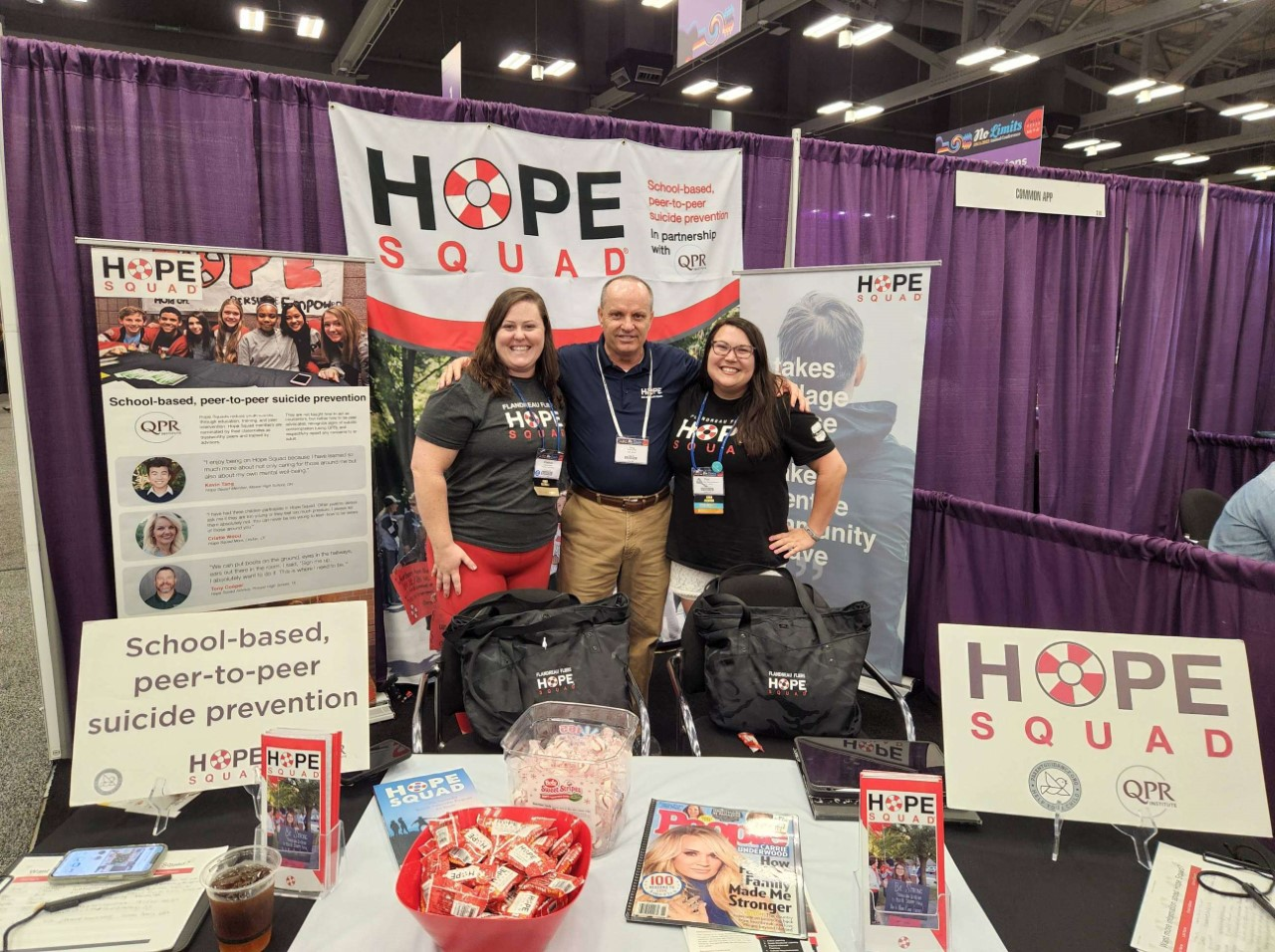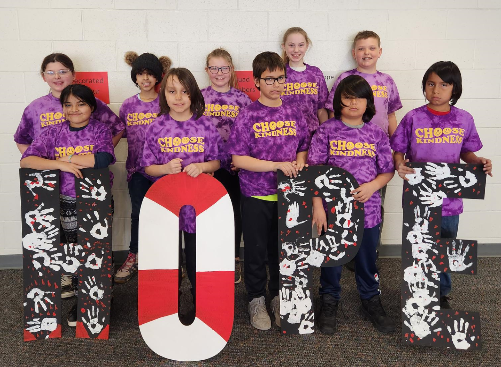
Stu Whitney/South Dakota News Watch
A suicide prevention program for teens is gaining traction in South Dakota schools, empowering students to look after one another and break down stigmas about depression.
Hope Squad, which operates in 41 states and Canada, uses a simple but powerful premise. Students are asked to name three peers they would turn to if they were struggling emotionally. Those lists help educators choose team members, who are trained how to recognize signs of suicide contemplation and abuse, and when to get trusted adults involved.
Sometimes just having someone to talk to represents a breakthrough.
“I learned that it’s OK to be nervous,” said Kiley Westberry, a freshman Hope Squad member in Flandreau, which was the first South Dakota school district to adopt the program. “It’s OK to not be able to fix everything. Sometimes you need to get other people to help.”
Coordinated with mental health agencies and supported by recent state funding, the student-focused trend comes at a time of heightened concern about teen suicide on the heels of the COVID-19 pandemic.
Suicide is the leading cause of death for young people aged 10-29 in South Dakota, according to South Dakota Department of Health data. The state had the sixth-highest age-adjusted suicide rate in the U.S. in 2021 (22.9 deaths per 100,000 individuals), compared to a national average of 14.1.
In the 2023 Legislature, House Bill 1079, sponsored by Republicans Rep. Taylor Rehfeldt of Sioux Falls and Sen. Sydney Davis of Burbank, appropriated $2 million to the Department of Health to provide grants to support mental health and suicide prevention programs tailored for youth, high school and college populations. Gov. Kristi Noem signed the bill into law March 23.
The issue is personal for Rehfeldt because of her own experience as a suicide loss survivor. Her uncle took his own life, and she witnessed the traumatic impact that tragedy had on her family.
“It really broke my dad,” said Rehfeldt, a registered nurse anesthetist at Sanford Health. “He’s worked through that a lot over the last five to 10 years, but I’ve seen how it really impacts families and individuals generationally.”
‘Our world is a different place’
Rehfeldt envisions programs such as the Hope Squad providing young people with avenues to be more open about feelings of insecurity in a social media era when pressures and hopelessness can mount quickly.
“I think the first part is just recognizing that mental health doesn’t have to be taboo, and that it’s an important part of physical health,” said Rehfeldt. “Maybe 20 years ago, you didn’t talk about how you felt or how things were pressing on you, but we have to talk about those things with people we trust. I think our world is a different place.”
The first round of contracts, effective from Aug. 1, 2023, through May 31, 2024, provided $250,000 to the Helpline Center in Sioux Falls to purchase curriculum and implement, train and support Hope Squads at nine schools in South Dakota. There also will be suicide loss response planning and protocol development with K-12 schools. The Department of Health is leveraging federal funds as part of these contracts.
In addition, $390,000 went to supporting Peer2Peer, a mentoring program for college students administered by Lost & Found, a nonprofit suicide prevention organization in Sioux Falls.
A third grant for $192,000 went to Mountain Plains Evaluation in Salem, which will conduct an assessment that compiles and analyzes epidemiological data related to mortality, suicide ideation and mental health in South Dakota.
Hope Squads were already established in Flandreau, Platte-Geddes, Brandon Valley and Scotland using grant money from the Utah-based Cook Center for Human Connection.
Helpline Center CEO Janet Kittams said her organization has enrolled four schools in the Harrisburg district (three middle schools and the freshman academy) as well as Brookings and White River as part of the publicly funded program. They are working on adding more schools.
“Hope Squad offers a critical option for students to receive support through their peers,” said Kittams. “The more opportunities we can create for students to reach out for help, the more likely they are to seek that help.”
Hope Squad program started by Utah principal
The national Hope Squad program was created by former Utah high school principal Greg Hudnall, who said he reached a breaking point in 1997 after getting a phone call that one of his students had killed himself in a public park – one in a string of tragedies in the school district.
“That’s when I told myself, ‘I’m done. I can’t take any more of this,’” Hudnall told People Magazine in 2019. “I vowed that I would do everything I could to prevent it from ever happening again.”
Flandreau was one of 12 school districts chosen nationally as grant recipients in 2021, with the pandemic still causing loss of structure and sometimes family tragedy for South Dakota youth. The state’s 2021 Youth Risk Behavior Surveillance System revealed that 21.5% of high school students said they considered suicide, while 12% said they had attempted it.
The crisis is particularly staggering for Native American youth, whose suicide rate is estimated by the South Dakota Department of Health to be 2.7 times higher than the white population. Flandreau High School, which has a Native enrollment of 30%, strives to reflect those demographics with its Hope Squad efforts.
“The program focuses on the protective factors of suicide prevention while creating more school connectedness,” said Flandreau school counselor Kari Lena-Helling, who supervises Hope Squads for grades 7-8 and grades 9-12.

‘I’ve definitely felt a change’
Flandreau has 84 total students involved with four Hope Squads: grade 4, grades 5-6 (Junior Hope Squads), grades 7-8 and grades 9-12. The elementary school groups are focused more on anti-bullying messages and being a good friend, while the upper levels get more in depth about suicide prevention strategies.
Students are chosen through peer nominations and discussions with principals and teachers, followed by training to recognize suicide/mental distress warning signs and QPR: question if they are thinking about suicide, persuade to get help, refer to a trusted adult. Confidentiality and the need to get adults involved in the process are paramount.
The Hope Squads meet every week and sponsor a Hope Week in the spring, with dress-up days and other events to bring a message of connectedness to their classmates, or what the advisers like to call “suicide prevention without being in your face.”
“We wanted to make sure the kids involved felt comfortable when it started,” said Chelsea Greenfield, who advises the younger grades. “I’ve definitely felt a change.”
One high school Hope Squad member came back after summer break and shared that a classmate was struggling with suicidal thoughts. Advisers were able to reach out to that student’s parents and suggest a mental health assessment, preventing a possible tragedy.
“I would say that every year we have students who struggle with suicidality and self-harm,” Lena-Helling said. “I think the difference is that kids are starting to get help for their peers sooner by recognizing warning signs, so you’re not seeing as many actual attempts.”
Giving counselors an assist
These student-involved efforts complement the work of school counselors, who are tasked with providing not just academic and vocational guidance but emotional support to students and families.
Forging that many personal connections is difficult, so schools are exploring ways to supplement traditional counseling with professional partnerships to make sure teens get the attention they need.
South Dakota has a ratio of about 365 students to every counselor, on par with neighboring states Iowa (370:1), Nebraska (369:1) and North Dakota (297:1). The American School Counselor Association recommends a ratio of 250:1.
In the Sioux Falls area, medical providers such as Avera Behavioral Health, Southeastern Behavioral Health and the Lutheran Social Services PATH program partner with school districts and take on referrals. The Helpline Center encourages students experiencing suicidal thoughts or needing emotional support to call or text 988 to speak with a trained crisis counselor 24 hours a day, seven days a week.
For many students, though, it helps to have a guiding hand and familiar face in school hallways to counter feelings of hopelessness. Even if sharing those emotions feels uncomfortable at first.
‘More kids are willing to talk’
Leah DeHaan, a 2023 graduate of Platte-Geddes High School, recalled her reaction when the school started a student-led Hope Squad through a Cook Center grant her junior year.
“I was skeptical,” DeHaan told News Watch in 2022. “As a teen who has suffered from mental health issues myself, I was concerned that it was just shifting responsibility off the adults and onto the students, like they were using students as makeshift therapists.”
She had a conversation with Platte-Geddes school counselor Sadie Hanson, who assuaged DeHaan’s concerns and told her that the fact that she voiced them made her a perfect candidate to serve on the Hope Squad.
DeHaan said she struggled with depression and anxiety in middle school and the beginning of high school. Her breakthrough came when talking candidly about what she was going through and being part of the team.
“Slowly we broke it down, and it became easier to discuss,” DeHaan said, “Now you see more kids around here willing to talk about their own struggles, the medications they need to take and how they plan to move forward.”
How to get mental health help and watch video series
Resources to get help for yourself or someone else who may be considering suicide:
The Helpline Center: People across the state can be connected to a crisis counselor 24/7 through the 988 Lifeline by call, text or chat.
- Call: 988
- Text: 988
- Chat: 988lifeline.org/chat
Front Porch Coalition: 605-348-6692
National Suicide Prevention Lifeline/Indian Health Service hotline: 800-273-8255 (TALK)
Crisis Text Line: Text CONNECT to 741741
Animated Series: mylifeisworthliving.org
